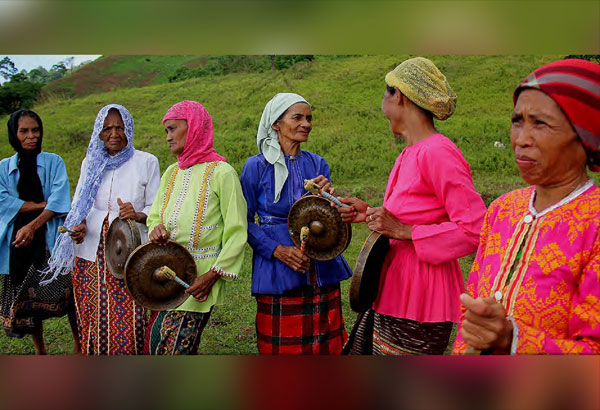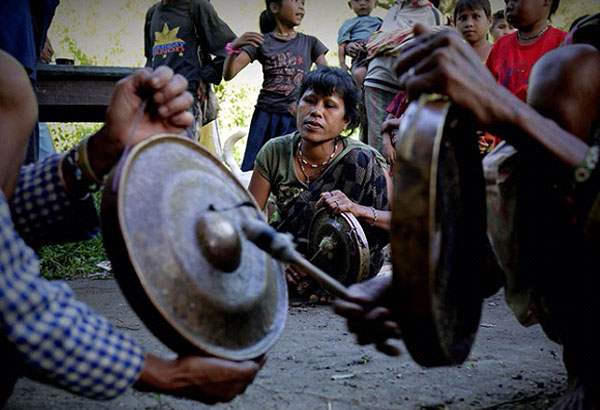Precarious lives: Women in indigenous communities

Dulangan Manobo women are among the indigenous peoples of Central Mindanao. Photo courtesy of IPDEV
Barangay San Jose in South Upi, Maguindanao is dominated by Indigenous Peoples (IPs)—with three of its seven puroks (barangay subdivisions) occupied by the Dulangan Manobo. Hills and mountains with very steep slopes—treacherous rather than scenic, denuded now of former forest cover by private logging firms—guard the barangay’s approach. A trip from the poblacion (municipal capital) by habal-habal (motorcycle) can cost P800-P1,000. The residents themselves generally walk—six to eight hours—perhaps twice that time in the rain. Today, Barangay San Jose has been classified as a Geographically Isolated and Difficult to Access (GIDA) area by the Philippine government.
Such situations are far from unique whenever we talk about IPs. In fact, in terms of welfare and development, it is not the IPs we see living in cities, towns and municipalities that merit special attention. It is the IPs living on ancestral lands that are noted by the Constitution and laws such as the IPRA (Indigenous Peoples’ Rights Act of 1997). Many of them live in GIDA areas. The right—indeed, the desire—to do so is exactly what such laws were intended to support and protect. And yet, this very feature of indigenous life presents a plethora of complications to government agencies and IPs alike when it comes to supplying even a bare minimum of basic human services.
From the comfort of the city, it’s easy enough to ask, “So why don’t they move to town if they want medical attention, education and other services?” Just as it’s easy enough for critics and pundits to say, “And why doesn’t the government see to it that they have electricity, clean water or the services of a trained midwife?” But these attitudes can directly contradict the intention of the law itself: that Indigenous People have the right to preserve their culture and their ways of life.
But what about roads, for example? Can’t the government at least build roads, one might ask? The truth is, many IPs have a severe distrust of roads—with good reason. They provide access to illegal loggers, miners and ready supply lines for armed groups—not to mention the military. And all of this says nothing of the mobility many indigenous groups depend on for their traditional lifestyles. Many IPs would tell you that such trappings of “civilization” have already brought much of their ancestral domain to ruin.
The truth is: the actual welfare, development and anti-poverty needs of IPs are not that different from the needs of the poor anywhere. There are, however, two significant differences—the intensity of needs and the difficulty of fulfilling those very needs.
ARMM provides the Dulangan Manobo of Barangay San Jose with a day care center and elementary school, a barangay health center, and DSWD’s conditional cash transfer (CCT) program. But there is no high school. The health center is under staffed and under supplied. Only two tranches of CCT payments have been made, but there is no doubt that the conditionalities—children attending school and they and their mothers receiving medical attention—can be very difficult to fulfill, given the barangay’s circumstances.
Worse still, public health has proven to be problematic. Residents report being charged P35 for contraceptives that—under the RH law—are supposed to be free. It is also no doubt the lack of education that leads many Dulangan Manobos to believe vaccinations to be poisonous—though the lack of electricity for refrigeration might lend some credence to such suspicions.
With no electricity, light is provided either by kerosene lamps or the bulitik—a lamp fueled by the sap of the lawaan tree. In turn, women must carry water from nearby streams or hand-dug wells, making water-borne diseases common. In view of expense and availability, traditional medicine—generally available for free or though barter—is frequently called upon. Births are usually attended by tribeswomen with varying degrees of experience and training. Prenatal care is—for reasons having to do with education—frequently non-existent.

A Dulangan Manobo ensemble plays brass gongs to kick off a community meeting. Photo by Bj Patiño
The Pambansang Koalisyon ng Kababaihan sa Kanayunan (PKKK)—the National Coalition of Rural Women—with the support of United Nations Women, has conducted a revealing study of the Dulangan Manobo women in Barangay San Jose. Most, it would seem, are dependent upon agriculture. They plant corn, rice, coffee, and cassava for personal consumption and to barter for other needs on market days. Many work as paid farm hands, earning around P100 per day. The income is not enough to meet basic needs, so they often go hungry, and find it difficult to buy other necessities like medicine.
Indigenous women are supposed to be legally protected in a number of ways, the Constitution tells us. “The State recognizes and promotes the rights of indigenous cultural communities within the framework of national unity and development.” The IPRA mandates respect for indigenous peoples’ inherent rights: the right to self-determination, to ancestral domains and the applicability of customary laws governing property rights. Self-determined development requires free, prior, informed consent in relation to developments in recognition of those ancestral domain rights.
The Magna Carta for Women recognizes women’s rights more broadly, including equal access to education (only one in four Dulangan Manobo girls finishes elementary, note), protection from violence, right to health (including food security and maternal health), social protection, and in all matters relating to marriage and family relations.
But it is in the status of women in particular where we once again come to a problematic intersection between the Local Government Code and our national government reality. For instance, their traditional practice of early marriage—as early as 12 years, and pregnancy—as early as 15 years old—remains a shockingly unresolved constitutional issue. Our nation’s law sets the minimum age for marriage at 18—but the Constitution “recognizes and promotes the rights of indigenous cultural communities.” The Magna Carta for women guarantees “protection in all matters relating to marriage and family relations,” but the IPRA ensures “the applicability of customary laws.”
Are we to expect the municipality of South Upi to bring this issue to court for clarification? Will the province of Maguindanao do so—or even ARMM? While we attempt to resolve these legal conundrums, families, in the meantime, are marrying off 12 year-old girls.
This is just one of the more dramatic and obvious areas in which Local Government Units (LGUs)—and ARMM itself—are out of their depth, especially in GIDA areas. How to address infant and maternal mortality rates? Or the need for clean drinking water? At what level do LGUs serving IPs in GIDA areas become truly effective? How, for that matter, can we assure that LGUs eventually—hopefully soon—become more capable of dealing with such complex issues?
Female IPs are among the poorest and most marginalized sectors of Philippine society. They experience neglect and discrimination in the provision of basic social services. Mindanao—where 61% of all IPs live—contributes 31 percent to the country’s total poverty incidence. It has the highest poverty and subsistence incidence among the major island groups in the country.
Yet the 2014 national budget shows that regions with the highest number of IPs get the smallest allocations from the government (Cordillera Autonomous Region: 1.22%, CARAGA: 1.38%, Region IX: 1.58%). This lack of budget has resulted in the poorest living conditions and highest incidence of poverty in regions where IPs are found. In short, social service provision in indigenous territories is far below that of the rest of the country.
It had been hoped that the Bangsamoro Basic Law (BBL) would help facilitate a revamp of the current ARMM style of governance, leading to more inclusive programs and administration—more bottom-up participation in expressing the fears, needs and aspirations of indigenous communities—even though the Dulangan Manobo of Barangay San Jose noted that, while some other Dulangan Manobo communities had been consulted during the drafting of the BBL, they were not.
Unfortunately, the BBL currently languishes in legislative limbo—perhaps because incumbents seeking reelection fear that, whether they vote yea or nay, it’s still likely to cost them at the polls.
Our past dealings with indigenous peoples—for all their good intentions—have borne mostly bitter fruit. Doing better will require concerted consultations among the IPs, local and national government agencies acting to address the most immediate needs of their communities—including women—in ways that are consistent with their cultural priorities. Even more imperative is the need to question the alleged militarization of IP areas, placing more stringent regulations on mining and logging industries that wreak havoc on lumad lives. Legal loopholes and contradictory laws have to be aligned with the actual conditions of indigenous peoples. Finally, in the coming elections, it is imperative to put IP issues front and center, and insist that candidates spell out their positions on the dire conditions confronting these most marginalized of cultural communities.
- Latest
- Trending
























